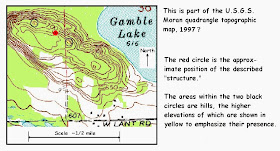"WHAT??" writes Professor Emeritus R.V. ("Dick") Dietrich, "This "structure" is an example
of accumulations of stones with similar upland locations within the area.
Each of these stone piles is considered to be an ancient artifact by the local
people who know them well. In addition, some of these people have
indicated their beliefs that the piles were likely made by, for example,
neolithic "stone-age" aborigines, Celtic Druids, Vikings or
pre-Columbian Native American Indians. Whomever, it seems safe only to
say that these "structures" were made after the last removal of
glacial ice from the area, which was about 11,000 years ago.
The geographical locations and
interrelations of most of these accumulations of stones are frequently cited to support the
hypothesis that they are meaningful artifacts -- i.e., they are not just stones
that were put where they are in order to clear the land. In support of this
aspect of the hypothesis, it is indeed quite evident that the land surrounding this
accumulation of stones would have never been cleared for, for example, farming
(see the map), and, indeed, there
are several stones that I believe would have been removed and become part of
this group had that been the purpose. In addition, it seems noteworthy that this structure
is on what would have an island in during the so-called Algonquin and
Nipissing stages of the Great Lakes. And, if only a few or no trees etc.
were present, nearby areas of the lower-level Lakes Chippewa and Stanley as well as of the more recent,
and current, Lakes Michigan and Huron could have been seen from this
location.
One professional archaeologist is said to have looked at this group of stones and suggested that this structure represents a "post-American Civil War lime kiln." Nothing that I have seen or been able find nearby seems to support that suggestion. The only other suggestion that I have heard is that it may have been a place where fires were built to heat maple sap to make syrup. Consequently, the given heading seems appropriate until the origin(s) and use(s) of this and other accumulations of stones in similar settings are proved.
One professional archaeologist is said to have looked at this group of stones and suggested that this structure represents a "post-American Civil War lime kiln." Nothing that I have seen or been able find nearby seems to support that suggestion. The only other suggestion that I have heard is that it may have been a place where fires were built to heat maple sap to make syrup. Consequently, the given heading seems appropriate until the origin(s) and use(s) of this and other accumulations of stones in similar settings are proved.
For
the record: The outside "circumferance"
of this roughly circular structure is approximately 55 feet; the
"diameters" range from about 16 to 20 feet; the inside diameter
ranges from approximately 6 to 8 feet; the height of the wall, the top of
which is roughly horizontal, ranges from about 3½ to 4½ feet above the surrounding uneven
ground-level; the "floor" of the central part is about 1½ feet above the "average"
surrounding ground-level. The constituent stones are largely "limestone" rubble
but "hard-rock" boulders are also included -- see close-ups.
That is to say, both stones from the rubble of fairly nearby formations and stones transported from Ontario by
glacial ice during the last "Ice Age" are included. This
makeup, of course, is one of the criteria that establishes the date of creation
of the structure as post-the most recent "Ice Age" glaciation.
The topography of the nearby area led to my thinking of this structure it as analogous to a multi-jeweled pendant on a dowager's breast --see the section of the topographic map area that is included. As might be expected, other people who are familiar with these relationships have alternative interpretations."
The topography of the nearby area led to my thinking of this structure it as analogous to a multi-jeweled pendant on a dowager's breast --see the section of the topographic map area that is included. As might be expected, other people who are familiar with these relationships have alternative interpretations."
Found
in the middle of a lengthy collection of some thing called:
STRAITS' STONES: A Picture Album
Fieldstones -- Buildings and Other Uses
Volume I. Mackinac County
© 2011
- mostly about historic use of fieldstones, but with some boulders "thrown in" at: http://stoneplus.cst.cmich.edu/1,A,Straits-ToEdit.html
On a related page this poem was found:
"As you continue to build your relationship with stones,
be aware of the stones around you when you are out walking.
See if one calls to you. If it does, pick it up and hold it.
See what you can learn.
If there are no stones where you walk, get a bowl full of stones for your house or apartment."
(unattributed)
be aware of the stones around you when you are out walking.
See if one calls to you. If it does, pick it up and hold it.
See what you can learn.
If there are no stones where you walk, get a bowl full of stones for your house or apartment."
(unattributed)
& this as well:
"Again, a request: If anyone has suggestions for things to be included with these Addenda -- e.g., additional uses of so-to-speak raw stones OR anything else about stones that seems especially noteworthy -- Please contact me via email at: diet1rv@cmich.edu "
The Professor also has a section on wooden fences:


We all agree such "donuts" are common throughout the east coast? Right?
ReplyDeleteI guess someone should tell these U.Mich guys.